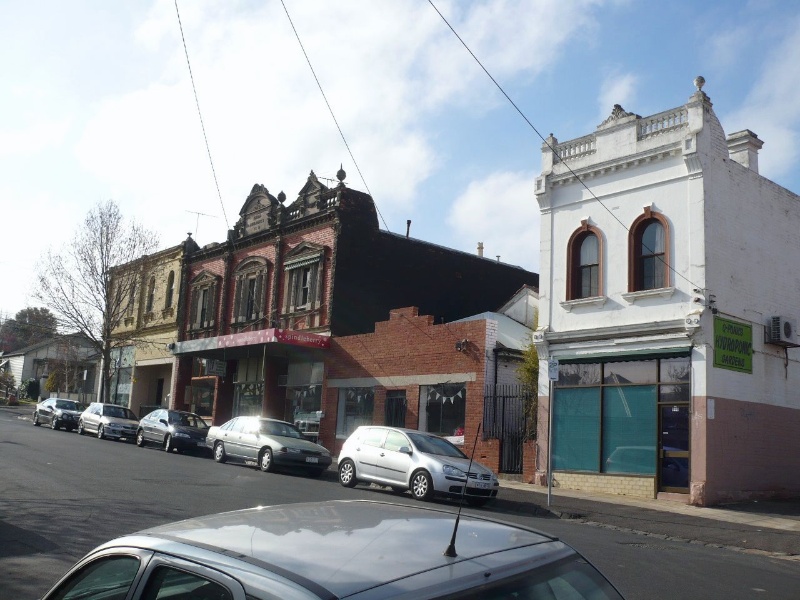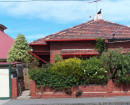Lorne St
1-47 and 2-54 LORNE STREET, 81-95 and 80-104 MARIBYRNONG ROAD and 254-56 and 270-284 UNION ROAD, MOONEE PONDS
-
Add to tour
You must log in to do that.
-
Share
-
Shortlist place
You must log in to do that.
- Download report



Statement of Significance
The Lorne Street precinct in Moonee Ponds is a residential area with some commercial development in Union Road, which was developed from the late nineteenth century to the late inter-war era. The housing predominantly comprises Victorian era double-fronted villas with some terrace rows, which are interspersed with Edwardian and Queen Anne revival houses, and inter-war houses in a variety of styles. The following elements contribute to the significance of the precinct:
1. The houses and any associated early/original front fences, as appropriate, at:
- 1-5, 9-35, 39-47 & 2-52 Lorne Street
- 81, 85-95 & 80-84, 86-90 & 92-102 Maribyrnong Road
2.The (former) shops and residences at:
- 102A, 102B, 104 Maribyrnong Road
- 254-256, 270 & 276-284 Union Road
Key attributes that contribute to the significance of this precinct include:
- the consistency of scale (one storey residential and double storey for commercial), form, siting (uniform or similar front and side setbacks), and original materials and detailing (weatherboard, face brick or render with iron or tiled hip or gable roof, verandah with cast iron or timber detailing) of the contributory buildings
- the high degree of intactness to the late nineteenth century and early-mid twentieth century development dates with contributory buildings that typically survive with their presentation to the street being largely intact
- low height of fences meaning that dwellings are visible from the street
- road alignments and allotment patterns resulting from the nineteenth century subdivision
- the relative absence of vehicle accommodation including driveways and crossovers
- the bluestone laneways and remnant bluestone kerb and channelling.
Other houses in the precinct, the single storey commerical building at 272-74 Union Road, post-WWII fences, and non-original alterations or additions to contributory places are not significant.
Note: The Fire Station at 258-260 Union Road is of individual local significance - please refer to the separate Hermes record.
How is it significant?
The Lorne Street precinct in Moonee Ponds is of local historic, architectural and aesthetic significance to the City of Moonee Valley.
Why is it significant?
It is historically significant as a typical example of the middle-class housing estates that proliferated in suburban Melbourne during the prosperous 'Boom' period of the 1880s and early 1890s. The Victorian-era shops in the adjacent portion of Union Road provide evidence of associated commercial development during this significant period, while the later housing illustrates the recovery and infill development that occurred in the early twentieth century. The consistency of built form and the extent to which the key eras of development are clearly apparent provides a vivid illustration of this pattern of settlement. (Criteria A & D)
It is architecturally and aesthetically significant as a fine example of a middle class residential area, which is notable for consistent quality of its built form and the high degree of intactness from the key phases of development. (Criteria D & E)
-
-
Lorne St - Physical Description 1
This housing and commercial buildingsin this precinct reflect the distinct phases of development in the late nineteenth century and early to mid-twentieth century.
Victorian-era housing predominates. There are a small number of single-fronted terraces (e.g. Nos. 10, 14-22, 26 & 46 Lorne Street, and the row of three at Nos. 91-95 Maribyrnong Road), but the Victorian housing is otherwise in the form of detached double-fronted villas, either with symmetrical or asymmetrical frontages. With the exception of a few block-fronted timber villas in Lorne Street (e.g., Nos. 24, 27, 48 & 50), the houses are of brick construction. The (originally) identical block fronted villas at Nos. 48 and 50 were most probably constructed by the same builder and are distinguished by the round-headed windows to the projecting bay. Most other houses are of bi-chromatic brick; many (e.g., Nos. 6, 9, 11-17, 34, 46 Lorne; 92 & 98 Maribyrnong) still retain tuck-pointing white others (e.g. 18 Lorne) have been sandblasted or overprinted (14, 22, 40 Lorne; 88 Maribyrnong). Only a few houses are rendered (e.g., 26 & 31 Lorne; 82 & 88 Maribyrnong), some with a ruled ashlar finish (e.g., 38 & 44 Lorne; 86 Maribyrnong).
The Victorian villas have hipped rooves, clad in either state or corrugated galvanised steel, although some have been reclad in modern terracotta tiles or pressed metal sheeting. Most retain their original chimneys in either bi-chromatic brick with render or fully rendered. Many houses have canted bay windows (e.g., Nos. 10, 16, 24, 32 & 36 Lorne and 82, 86, 90 Maribyrnong) while others have tripartite windows or paired double-hung sash. Most entrance doors have highlights and sidelights.
All of the Victorian houses have verandahs, variously with bull-nosed, bell-cast or skillion rooves of corrugated galvanised steel, supported on cast iron columns or stop-chamfered timber posts, with ornate friezes of cast iron lacework. No.34 is a notable example with a central gablet that is echoed by the main roof behind. In Lorne Street return verandahs are unusual (uniquely represented at No.30), although there are some in Maribyrnong Road (e.g. Nos. 86 & 92). Some of the houses (e.g., 20 Lorne, 95 Maribyrnong) have had their cast iron lacework friezes removed, while others (e.g., 26 Lorne, 98 Maribyrnong) have had their verandahs altered or rebuilt with new flat rooves supported on mild steel trellises or metal pipes. The original verandah at No. 40 Lorne was replaced by a porch during the inter-war period - a more sympathetic verandah has since been re-instated.
The Victorian-era fabric within the precinct also includes several shops, all located in Union Road. There is a typical single-storey rendered brick 'corner store' at the Maribyrnong Road intersection (Nos. 102B & 104) and several ubiquitous terraced shops with dwellings above (Nos. 254-256, 270, 276-284). They are of brick construction with typical Boom-era rendered embellishments in the form of window surrounds, cornices, pilasters, pediments and balustraded parapets. There is some variation in their finishes: No.270 is fully rendered, the shops at No.254-56 and 282-84 are over-painted brick, and the so-called Union Building at No.276-80 - the most intact of them all - is face red brick with unpainted render trim and has some original shop fronts.
The few Edwardian houses, mostly situated in Lorne Street (e.g., Nos. 8, 12 & 29), are usually in the form of small asymmetrically-composed red brick villas in the Queen Anne Revival idiom, characterized by rendered banding and hipped rooves clad in slate or corrugated galvanized steel. A notable exception is Edenhope at 80 Maribyrnong Road, a substantial and prominently sited Edwardian house with some particularly fine detailing including multiple verandahs with turned timber posts, canted bay windows, rough cast render and ruled ashlar.
The inter-war houses in this precinct are comparable in scale (single-storey) and materials (e.g., face brick construction and terracotta tiled rooves), but diverse in style. A number of specific idioms are represented, namely Tudor Revival (e.g. Nos. 1 & 43 Lorne), California Bungalow (3 & 5 Lorne), and Moderne (80a Maribyrnong), as well as some less distinguished dwellings of less determinate style (4 & 7 Lorne, 84 Maribyrnong). The few post-war buildings in the precinct include houses and double storey flats.
Lorne Street itself has concrete kerbing, broad nature strips, particularly on the north side, and no street planting of note; the fabric of the street is otherwise distinguished only by unusual bluestone kerbing along the inside of the concrete footpath on the south side of the street. The laneways that run along the rear of the properties fronting both sides of Lorne Street also retain their original bluestone pitching. Fencing is generally low, allowing views of the housing, and although there don't appear to be any original fences many houses have reproduction timber picket or cast iron fences in an appropriate style.
Note: The houses at 2 & 29 Lorne Street and 80 & 82 Maribyrnong Road, and the Fire Station at 258-260 Union Road are of individual heritage significance and have their own place record, which provides further information.
Heritage Study and Grading
Moonee Valley - Review of HO precincts
Author: David Helms HPM
Year: 2010
Grading: LocalMoonee Valley - City of Moonee Valley Heritage Review 2004
Author: Heritage Alliance
Year: 2004
Grading:Moonee Valley - Essendon Conservation Study
Author: Graeme Butler
Year: 1985
Grading:
-
-
-
-
-
INFANT BUILDING, MOONEE PONDS WEST PRIMARY SCHOOL
 Victorian Heritage Register H1321
Victorian Heritage Register H1321 -
FORMER ASCOT VALE TRAM SUBSTATION
 Victorian Heritage Register H2323
Victorian Heritage Register H2323 -
HOUSE (LYNDHURST, NAMLOC) & STABLES
 Moonee Valley City
Moonee Valley City
-
"1890"
 Yarra City
Yarra City -
"AMF Officers" Shed
 Moorabool Shire
Moorabool Shire -
"AQUA PROFONDA" SIGN, FITZROY POOL
 Victorian Heritage Register H1687
Victorian Heritage Register H1687
-
'ELAINE'
 Boroondara City
Boroondara City -
-oonah
 Yarra City
Yarra City -
..eld House
 Yarra City
Yarra City
-
-















